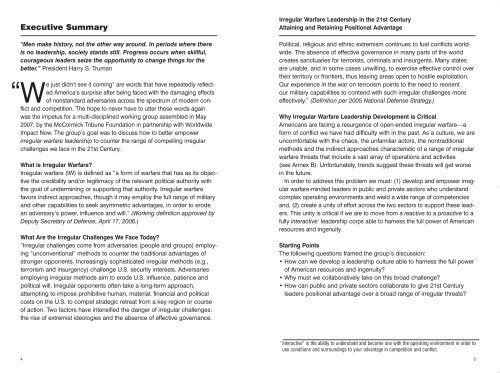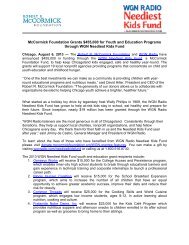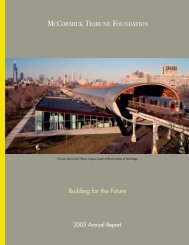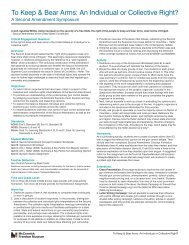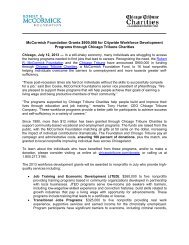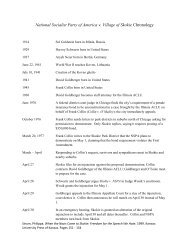Irregular Warfare Leadership in the 21st Century
Irregular Warfare Leadership in the 21st Century
Irregular Warfare Leadership in the 21st Century
You also want an ePaper? Increase the reach of your titles
YUMPU automatically turns print PDFs into web optimized ePapers that Google loves.
Executive Summary<br />
“Men make history, not <strong>the</strong> o<strong>the</strong>r way around. In periods where <strong>the</strong>re<br />
is no leadership, society stands still. Progress occurs when skillful,<br />
courageous leaders seize <strong>the</strong> opportunity to change th<strong>in</strong>gs for <strong>the</strong><br />
better.” President Harry S. Truman<br />
“<br />
We just didn’t see it com<strong>in</strong>g” are words that have repeatedly reflected<br />
America’s surprise after be<strong>in</strong>g faced with <strong>the</strong> damag<strong>in</strong>g effects<br />
of nonstandard adversaries across <strong>the</strong> spectrum of modern conflict<br />
and competition. The hope to never have to utter those words aga<strong>in</strong><br />
was <strong>the</strong> impetus for a multi-discipl<strong>in</strong>ed work<strong>in</strong>g group assembled <strong>in</strong> May<br />
2007, by <strong>the</strong> McCormick Tribune Foundation <strong>in</strong> partnership with Worldwide<br />
Impact Now. The group’s goal was to discuss how to better empower<br />
irregular warfare leadership to counter <strong>the</strong> range of compell<strong>in</strong>g irregular<br />
challenges we face <strong>in</strong> <strong>the</strong> <strong>21st</strong> <strong>Century</strong>.<br />
What is <strong>Irregular</strong> <strong>Warfare</strong><br />
<strong>Irregular</strong> warfare (IW) is def<strong>in</strong>ed as “a form of warfare that has as its objective<br />
<strong>the</strong> credibility and/or legitimacy of <strong>the</strong> relevant political authority with<br />
<strong>the</strong> goal of underm<strong>in</strong><strong>in</strong>g or support<strong>in</strong>g that authority. <strong>Irregular</strong> warfare<br />
favors <strong>in</strong>direct approaches, though it may employ <strong>the</strong> full range of military<br />
and o<strong>the</strong>r capabilities to seek asymmetric advantages, <strong>in</strong> order to erode<br />
an adversary’s power, <strong>in</strong>fluence and will.” (Work<strong>in</strong>g def<strong>in</strong>ition approved by<br />
Deputy Secretary of Defense, April 17, 2006.)<br />
What Are <strong>the</strong> <strong>Irregular</strong> Challenges We Face Today<br />
“<strong>Irregular</strong> challenges come from adversaries (people and groups) employ<strong>in</strong>g<br />
“unconventional” methods to counter <strong>the</strong> traditional advantages of<br />
stronger opponents. Increas<strong>in</strong>gly sophisticated irregular methods (e.g.,<br />
terrorism and <strong>in</strong>surgency) challenge U.S. security <strong>in</strong>terests. Adversaries<br />
employ<strong>in</strong>g irregular methods aim to erode U.S. <strong>in</strong>fluence, patience and<br />
political will. <strong>Irregular</strong> opponents often take a long-term approach,<br />
attempt<strong>in</strong>g to impose prohibitive human, material, f<strong>in</strong>ancial and political<br />
costs on <strong>the</strong> U.S. to compel strategic retreat from a key region or course<br />
of action. Two factors have <strong>in</strong>tensified <strong>the</strong> danger of irregular challenges:<br />
<strong>the</strong> rise of extremist ideologies and <strong>the</strong> absence of effective governance.<br />
<strong>Irregular</strong> <strong>Warfare</strong> <strong>Leadership</strong> <strong>in</strong> <strong>the</strong> <strong>21st</strong> <strong>Century</strong><br />
Atta<strong>in</strong><strong>in</strong>g and Reta<strong>in</strong><strong>in</strong>g Positional Advantage<br />
Political, religious and ethnic extremism cont<strong>in</strong>ues to fuel conflicts worldwide.<br />
The absence of effective governance <strong>in</strong> many parts of <strong>the</strong> world<br />
creates sanctuaries for terrorists, crim<strong>in</strong>als and <strong>in</strong>surgents. Many states<br />
are unable, and <strong>in</strong> some cases unwill<strong>in</strong>g, to exercise effective control over<br />
<strong>the</strong>ir territory or frontiers, thus leav<strong>in</strong>g areas open to hostile exploitation.<br />
Our experience <strong>in</strong> <strong>the</strong> war on terrorism po<strong>in</strong>ts to <strong>the</strong> need to reorient<br />
our military capabilities to contend with such irregular challenges more<br />
effectively.” (Def<strong>in</strong>ition per 2005 National Defense Strategy.)<br />
Why <strong>Irregular</strong> <strong>Warfare</strong> <strong>Leadership</strong> Development is Critical<br />
Americans are fac<strong>in</strong>g a resurgence of open-ended irregular warfare—a<br />
form of conflict we have had difficulty with <strong>in</strong> <strong>the</strong> past. As a culture, we are<br />
uncomfortable with <strong>the</strong> chaos, <strong>the</strong> unfamiliar actors, <strong>the</strong> nontraditional<br />
methods and <strong>the</strong> <strong>in</strong>direct approaches characteristic of a range of irregular<br />
warfare threats that <strong>in</strong>clude a vast array of operations and activities<br />
(see Annex B). Unfortunately, trends suggest <strong>the</strong>se threats will get worse<br />
<strong>in</strong> <strong>the</strong> future.<br />
In order to address this problem we must: (1) develop and empower irregular<br />
warfare-m<strong>in</strong>ded leaders <strong>in</strong> public and private sectors who understand<br />
complex operat<strong>in</strong>g environments and wield a wide range of competencies<br />
and, (2) create a unity of effort across <strong>the</strong> two sectors to support <strong>the</strong>se leaders.<br />
This unity is critical if we are to move from a reactive to a proactive to a<br />
fully <strong>in</strong>teractive 1 leadership corps able to harness <strong>the</strong> full power of American<br />
resources and <strong>in</strong>genuity.<br />
Start<strong>in</strong>g Po<strong>in</strong>ts<br />
The follow<strong>in</strong>g questions framed <strong>the</strong> group’s discussion:<br />
• How can we develop a leadership culture able to harness <strong>the</strong> full power<br />
of American resources and <strong>in</strong>genuity<br />
• Why must we collaboratively take on this broad challenge<br />
• How can public and private sectors collaborate to give <strong>21st</strong> <strong>Century</strong><br />
leaders positional advantage over a broad range of irregular threats<br />
1<br />
Interactive” is <strong>the</strong> ability to understand and become one with <strong>the</strong> operat<strong>in</strong>g environment <strong>in</strong> order to<br />
use conditions and surround<strong>in</strong>gs to your advantage <strong>in</strong> competition and conflict.<br />
4<br />
5


